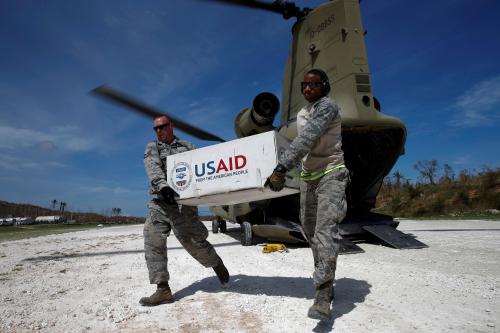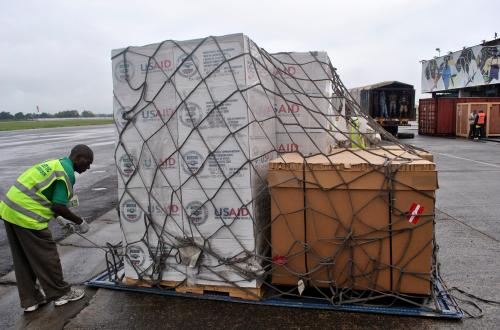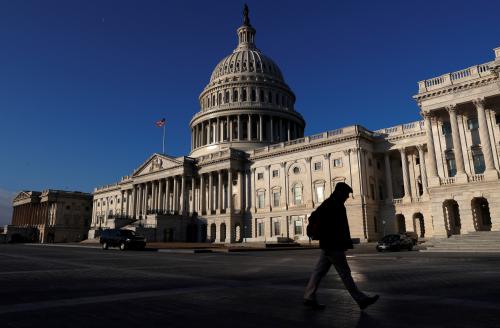On June 20, Brookings hosted the launch of the 2018 Aid Transparency Index, the only independent measure of aid transparency among the world’s major development agencies.
The index is produced by Publish What You Fund, a research and advocacy organization that promotes the advancement of aid transparency, largely through the International Aid Transparency Initiative (IATI). Under IATI, donors commit to publishing foreign assistance data and information in the common IATI standard, thus providing information that is comparable and accessible in one place.
At the event, panelists discussed how public access to how aid is spent is a valuable asset to tackling many global challenges. Below are a few of the key themes.
Why aid transparency is important
Why make aid data publicly available? The reasons are multifold. Access to a comprehensive set of aid data allows donors, partner governments, implementers, analysts, journalists, and citizens to identify what aid is being provided, what their government and other donors are doing, and what aid is needed. Good and accurate data allows development organizations to know where and how to target their assistance. Comprehensive data supports better coordination, better analysis, and better evaluation.
A statement in the 2016 High-Level Panel Report on Humanitarian Financing, while targeted at humanitarian assistance, articulates the need for transparency in all assistance:
“The more we know about how money is channeled through the global humanitarian system, the better equipped we are to allocate resources effectively and measure results. For donors to provide more flexible and predictable funding they need reliable, real-time, prioritized, comparable and open data on the needs that they are being asked to finance and the results produced by their funding.”
The good news in the 2018 Index is that there has been considerable progress on making aid data public, especially by multilateral development organizations. Special recognition should be given to the Asian Development Bank for its number one ranking, to the U.S. Millennium Challenge Corporation for maintaining its stellar record by coming in number five, and to USAID for making the most progress of any U.S. agency, putting itself solidly in the “good” category.
Challenges
As we look ahead to the next decade and the ambitions of the Sustainable Development Goals (SDGs), it is clear we face three big challenges:
First, achieving the SDGs will require vastly increased finance—trillions of dollars—well beyond the capacity of foreign assistance.
Second, the magnitude of resources directed to easing humanitarian suffering has exploded. In addition, there is urgency in building resilience through bridging the humanitarian and development divide.
Third, the practice of economic development is changing. Many developing countries can now finance much of their own development, but still need some external support. There is a widening array of donors, both public and private. Development finance—involving a range of public-private collaborations involving traditional aid donors, development finance institutions, private investment funds, blended funds, pooled funds, pension funds, and sovereign wealth funds—is expanding rapidly and needs to grow even faster.
The role of development finance
Development finance entities have different models, approaches, and missions. We need to know what they are doing and how they can be harnessed—or at least guided—to support good development.
Investments must be encouraged but the transparency standards that we have worked so hard to instill must be maintained. Without transparency, we lack the tools to facilitate collaboration between different finance organization, to ensure effective use of resources, and to hold institutions accountable.
Full transparency across all development finance organizations would provide a comprehensive map of who is financing what, for what purpose, and where. Having this information supports how resources are targeted. There are still investments for which assistance is the best source of funds, for example, governance and establishing the rule of law. There are other areas—like job creation—where private or blended capital flows make more sense. Having the full picture helps avoid the gaps and the duplication that happens far too often when information is not shared.
Accountability is particularly important in cases of institutions with missions that may not be poverty reduction or even development. How do we know whether investments are contributing to development outcomes without information on results?
Transparency, on its own, will not solve our development challenges. But it is essential to underpin better decisionmaking, coordination, and hopefully outcomes. Development experts know this from experience over the last decade.
Insights from development experts
While our event launching the 2018 Index reviewed the good progress certain donors have made in fulfilling their commitment to IATI, the panel provided a frank and sobering discussion of the hurdles to aid transparency and the challenges of moving from aid transparency to development transparency, that is, transparency of all financial flows for development.
Tessie San Martin, president and CEO of Plan International, which publishes its data to IATI, explained why committing to IATI was important and provided insights into the compliancy hurdles for a midsized international nongovernmental organization.
Joel Charney, executive director of the Norwegian Refugee Council, USA, and Aaron Rosenberg, chief for public affairs of the International Finance Corporation, similarly explained why their organizations have committed to IATI, but also how the IATI format does not always reflect what they do. The IATI structure was designed for reporting traditional development assistance. Some of the fields are not relevant or do not fully capture the nature of humanitarian assistance or development finance. A member of the audience raised a further issue of how to report contracting data—an important function for all development work, regardless of the source of funding. The question then is, how can IATI adjust to accommodate these expanded actors and new resources so that the full range of financial flows are captured?
The panelists agreed that, as difficult as the technical challenges of reporting to IATI are, the greater challenge is finding the political will—like getting senior level directors of organizations to lead—and changing organizational culture. They also acknowledged that data transparency, while by itself not transformative, is an essential tool to making development efforts inclusive, effective, and accountable.
The audience was seized as panelist Kathryn Kaufman’s, managing director for global women’s issues at the Overseas Private Investment Corporation, reiterated OPIC’s commitment to advancing women in economic development via its 2X initiative and, as an example of the importance of better data, the need for broader and deeper data on women and girls in order to advance their contribution to development.
Moderating the panel, Paul O’Brien of Oxfam America skillfully led the panelist through a discussion of the need to crowd in more finance and the private sector while not losing standards already achieved and building the will for a high level of transparency.
The value of the Aid Transparency Index
A recent academic analysis has determined that the index “has attained and exercised significant symbolic and normative power by defining clear indicators and benchmarks for donor transparency. Its authority derives from its independence and its process of working with donors and external reviewers.”
As organizations around the world work toward tackling the toughest development challenges, it’s clear that more, not less, transparency will be the key to efficient and effective aid. As such, the aid index will continue to be a tool for good.








Commentary
How better aid transparency will help tackle global development challenges
June 21, 2018